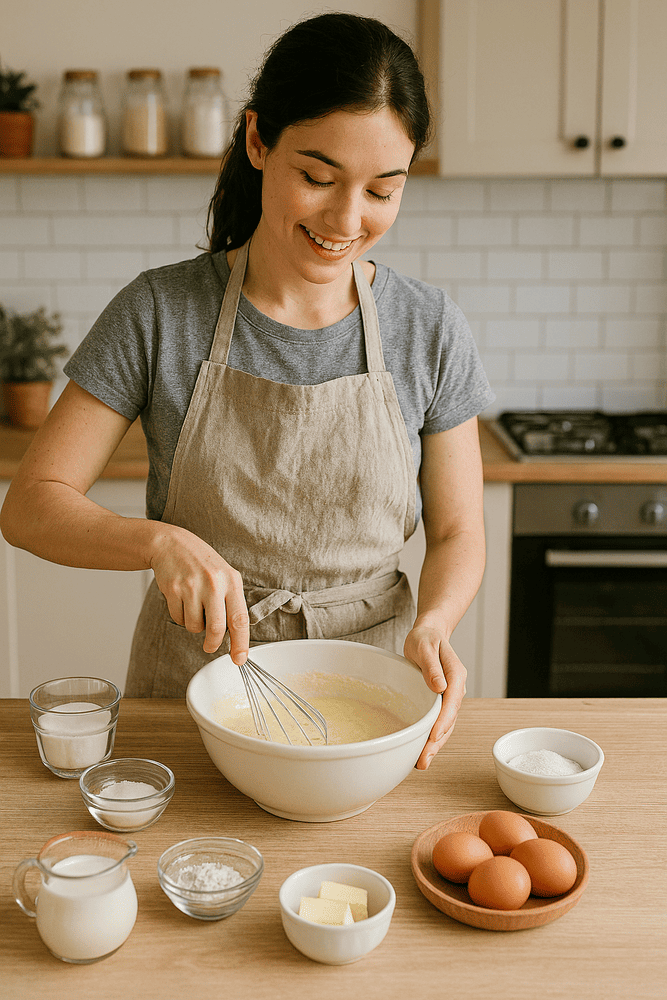Baking your first cake from scratch is one of the most satisfying things you can do in the kitchen. It’s creative, delicious, and surprisingly easier than you might think. Whether you’re baking for a birthday, a special moment, or just to try something new, this guide will walk you through every step to help you make your very first homemade cake with confidence. By the end of this post, you’ll know exactly what ingredients you need, how to mix them, how long to bake, and what to do if something doesn’t go quite right. Ready? Let’s begin your cake journey!
1. Choose a Simple, Reliable Recipe
Start with a cake that has a high success rate. Think vanilla cake, butter cake, or chocolate cake. These classic recipes are popular for a reason—they’re easier to follow and help you build foundational skills. Avoid recipes that include multiple layers, complex fillings, or unusual ingredients right away. You’ll have time for those later!
Pro Tip: Look for beginner recipes with fewer than 10 ingredients.
2. Understand What Each Ingredient Does
A good cake is about balance. Here’s how the most common ingredients work:
- Flour provides the structure.
- Sugar adds sweetness and keeps the cake tender.
- Eggs bind the ingredients and help it rise.
- Butter or oil makes it soft and moist.
- Milk or another liquid smooths the batter.
- Baking powder or baking soda gives lift and fluffiness.
- Salt enhances flavor.
Understanding the role of each ingredient helps you avoid common issues like dry cakes, sunken centers, or rubbery texture.
3. Prepare Everything Before You Start
The French have a saying: mise en place, which means “everything in its place.” Measure all your ingredients before you begin mixing. It reduces stress and avoids mistakes like forgetting sugar or using too much flour. You’ll also want to prepare your cake pan and preheat your oven at this stage.
4. Preheat the Oven and Prepare the Pan
A hot oven is essential for activating the leavening agents (like baking powder) at the right time. Set your oven to 350°F (180°C) and wait until it’s fully preheated before putting the cake inside. Grease your pan with butter or oil, then dust it lightly with flour. You can also line the bottom with parchment paper for extra safety against sticking.
5. Mix in the Right Order (and Don’t Overmix!)
Use this simple order for most beginner-friendly cakes:
- Cream butter and sugar together until light and fluffy.
- Add eggs one at a time, mixing well after each.
- Alternate dry and wet ingredients, beginning and ending with dry.
- Mix gently until just combined.
Don’t overmix! It’s one of the most common beginner mistakes—it can make your cake dense instead of fluffy.
6. Pour, Smooth, and Tap the Pan
Once your batter is ready, pour it evenly into the pan. Use a spatula to level the surface, then gently tap the pan on the counter to release air bubbles. This helps avoid large holes or uneven baking.
7. Bake—and Be Patient!
Place your cake in the center of the oven and close the door gently. Avoid opening it during the first 30 minutes—this helps keep the temperature stable and prevents collapse. Most cakes will take 35–45 minutes, but it depends on your oven and the size of the pan.
8. Test for Doneness
Use a toothpick or wooden skewer and insert it into the center. If it comes out clean (or with a few dry crumbs), your cake is done. If there’s wet batter, bake for a few more minutes and test again. Also, check if the edges have pulled slightly from the sides of the pan—that’s another good sign.
9. Let It Cool the Right Way
Remove the cake from the oven and let it sit in the pan for 10 to 15 minutes. Then, carefully turn it out onto a cooling rack. Let it cool completely before slicing or decorating—this prevents crumbling and melting frosting.
10. Add Your Personal Touch
Now that you’ve baked a successful cake, you can enjoy it just as it is or dress it up! Try:
- Dusting with powdered sugar
- Adding a simple glaze or drizzle
- Spreading jam or cream between layers
- Using buttercream or ganache for frosting
If decorating sounds exciting, check out our next articles on buttercream tips and easy decorating ideas.
Troubleshooting Tips (Bonus!)
Cake didn’t rise? You may have forgotten the baking powder, or the oven wasn’t hot enough.
Too dense? Probably overmixed.
Dry texture? It may have overbaked—try shortening the time slightly next time.
Cracked top? Oven temperature might be too high—use an oven thermometer to check.
Final Thoughts
Congratulations! You just made your first cake from scratch—a huge win. Remember, baking is a mix of science and love, and every cake you make teaches you something new. The more you bake, the more confident and creative you’ll become. Your next steps could be learning how to fix baking mistakes, exploring different cake types like sponge or layer cakes, or even trying vegan and gluten-free versions.
Continue Your Learning:
- 10 Common Cake Baking Mistakes and How to Avoid Them
- How to Make a Sponge Cake That Never Fails
- Understanding the Role of Eggs in Cake Baking
